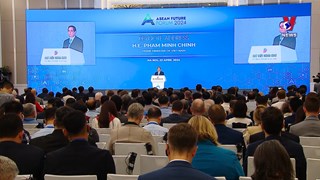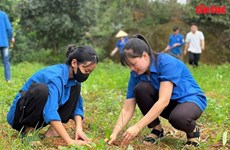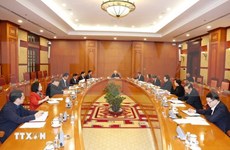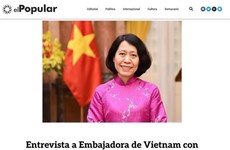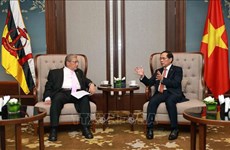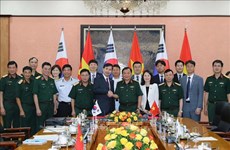Deputy PM’s remarks at 27th International Conference on the Future of Asia
 Standing Deputy Prime Minister Pham Binh Minh (Photo: VNA)
Standing Deputy Prime Minister Pham Binh Minh (Photo: VNA)
Hanoi (VNA) – Vietnam's Standing Deputy Prime Minister Pham Binh Minh on May 26 attended
and delivered his remarks at the 27th International Conference on the Future of
Asia in Tokyo, Japan.
The following is the full text of the remarks.
Mr. Tsuyoshi HASEBE, President and CEO of Nikkei Inc.
Distinguished
leaders,
Ladies
and gentlemen,
I am greatly honored to
address the 27th International
Conference on The Future of Asia, under the theme of "Redefining Asia's role in a divided
world". I applaud Nikkei's initiative to convene this
Conference, which provides a prestigious forum for policy exchanges,
contributing to strengthening regional cooperation, and fulfilling the goal of
prosperity and development for this continent and the world at large.
Asia
amidst historical and profound changes
Ladies
and gentlemen,
As we enter the third decade of the 21st century, Asia is witnessing historical and profound changes. Against such backdrop, we are faced with critical decisions, and intertwined and great opportunities and challenges, which may leave lasting impact upon future generations. Never before have the duality nature of and differences in the region and the world been so complicated and unpredictable. We can identify four primary trends with far-reaching developments.
- First, the
4th Industrial Revolution has
paved the way for a new development chapter for mankind, providing ample
opportunities for breakthrough developments. Such is the digital era. The
global economy is undergoing a fundamental transition, with novel economic
models. The space for the global economy has been expanded to an unprecedented
scale. Reform and innovation are prominent, with a new mindset and model for
development, business and management that are closely associated with the
digital economy, and sustainable, inclusive, green and balanced growth.
On the other hand, the 4th Industrial Revolution has also
brought about new and multidimensional challenges, from the widening
development gap, the risk of being outdated and inequality to other social
issues. Development challenges are increasingly prevalent, and are global in
nature.
- Second, while peace,
cooperation, connectivity and development remain the prevailing trends, we are
currently faced with increasing strategic competition, internal conflicts, and
the risk of division and confrontation. On the one hand,
multi-level linkages are increasingly expanded in depth and breadth, ranging
from FTAs to economic and trade ties to digital economy and digital technology.
On the other hand, geostrategic and geopolitical competition are intensifying
across multiple areas, protectionism is increasing, and present circumstances
are becoming more unstable and unpredictable.
- Third, the present
balance of power is rapidly shifting towards a multicentre model, in which Asia
will continue to be an integral economic, political and technological hub in the
world. As our region enjoys the harmonious resonance of fundamental
global values, and constitutes the intersection of trade flows, capital flows,
infrastructures and peoples, Asia thus possesses important foundations for
growth. The 21st century is also
considered to be the "Asian Century."
- Fourth, the COVID-19
pandemic has brought about a global crisis, causing far-reaching consequences
at national, regional and international level, and accelerating major shifts
which had emerged since the 2008 - 2009 crisis.
The pandemic has exposed systematic issues facing Asia,
such as development gap, institution, infrastructure, technology, and supply
chain. There are also management, healthcare and social challenges, natural
disaster, environmental pollution, and climate change. In addition, the
pandemic has also forced us to review our development mindset, with greater
priority given to new and sustainable development drivers, among which digital
transformation and green transition are key factors.
These trends and challenges have fostered new drivers to
unite Asia in offering a collective response.
It can be said that the next 10 to 20 years constitute a
critical period for the transition in Asia and the world as a whole.
In
this context, the Conference today provides a great opportunity to exchange
views on Asia's role in a turbulent world.
Asia's
responsibilities in the evolving situation
Ladies
and gentlemen,
For over nearly three decades since the first
International Conference on The Future of Asia, our continent has witnessed a
myriad of profound challenges and shifts, particularly the regional financial
crisis in 1997 - 1998, the global economic and financial crisis in 2008 - 2009,
and the COVID-19 pandemic. After each crisis, Asia not only managed to
collectively overcome all hurdles, but also emerged ever stronger. According to
the forecast between now and 2030, our region will continue to be the
fastest-growing area, and our share in the global GDP will increase from 45% to over 50%.
At present, the most important question at hand is: What
should Asian countries do to bolster cooperation, maintain regional prosperity,
and elevate Asia's role in global efforts toward recovery and development?
To that end, I wish to raise the following points:
First and foremost, Asia needs to play a greater
role in maintaining and fostering a peaceful and stable environment conducive
to development and prosperity in the region and beyond, on the shared basis of
cooperation, understanding, trust and responsibility. Through the lessons
accumulated over the past 75 years, it can be affirmed that development,
independence, and economic self-reliance cannot be achieved without
safeguarding peace, stability and cooperation.
Ensuring a peaceful environment in Asia over the past
years was not a simple accomplishment. Such peace owed much to the resolve,
unity and joint efforts of all nations in the region. Peace always remains as
the prerequisite for the development of all countries, and lays the solid
groundwork for cooperation across the board, from politic and economic ties to
socio-cultural collaboration within Asia, and between Asia and other partners
worldwide.
As the region and the world are focusing resources on
addressing urgent and unprecedented obstacles, countries ought to, above all
else, make responsible contributions to these joint efforts. It is necessary to
uphold mutual respect, and engage in fair and mutually beneficial cooperation.
In the region, territorial disputes at sea continue to
threaten peace and security. Regarding the East Sea, or the South China Sea, it is
necessary to peacefully settle disputes and conflicts in line with the rule of
law, particularly the Charter of the United Nations and the 1982 United Nations
Convention on the Law of the Sea (UNCLOS 1982). Countries also need to build
upon multilateral cooperation arrangements, fully and effectively implement the
Declaration on the Conduct of Parties in the South China Sea (DOC), and strive
to complete a substantive and effective Code of Conduct in the South China Sea
(COC) that is in line with international law, so as to maintain peace,
cooperation, and freedom of navigation and overflight in the
region.
Second, more than ever before, Asia needs to be a
pioneer in upholding multilateralism, and promoting cooperation in an open,
inclusive, fair, sustainable and rules-based manner. We need to adopt a global
approach to resolve increasingly urgent global issues. We need to bolster
cooperation and build trust among Asian countries, and enhance our resilience
and responsiveness amid rapid changes. At this juncture, all countries need to
put aside differences and stand united to support each other.
Accordingly, more than ever before, we need to enhance
the complementary nature of regional cooperation arrangements and linkages, and
establish a grid of regional networks.
Only by sharing common objectives and standing
shoulder-to-shoulder in taking bold action can we overcome challenges and
yielded excellent effectiveness in our collaboration. This is the consistent
position of ASEAN countries, and has been realized by ASEAN's active efforts in
bolstering its partnerships and ties, and upholding its centrality in its
relations with major powers within and outside the region, so as to contribute
to ensuring peace, security, stability, cooperation and development, and
addressing global development challenges.
In this globalization era, the establishment of a
self-reliant economy does not mean fostering a closed economy. On the contrary,
this entails creating an open and integrated market economy that is closely
associated with the world, with a view to harmoniously harnessing domestic and
external resources. The effective implementation of free trade agreements, such
as the CPTPP, RCEP, and other cooperation frameworks, will create more drivers
of economic recovery and growth in Asia and the world. In addition, in order to
make the most of opportunities provided by regional connectivity, countries
need to put in place and further improve a system of strategic infrastructure,
such as seaports, logistics, roads, and flight routes. It is also necessary to
step up people-to-people exchange via the promotion of tourism and
socio-cultural ties.
We do hope that international financial organizations
will continue to support Asian countries in terms of capital, wisdom, and
capacity building in these processes.
Third, we need to work closely together to ensure
the necessary foundation for growth recovery in all countries and Asia at
large, thereby ensuring Asia's role as a key driver for global
development. Asia
is the largest regional economy in the world, and the convergence of regional
economic networks and FTAs. As Asia enjoys the harmonious resonance of
fundamental global values, and constitutes the intersection of trade flows,
capital flows, infrastructures and peoples, this region thus possesses
important foundations for growth.
Asia also enjoys a myriad of advantages, as it is a
self-reliant and innovative region that is united in diversity, with
complementary economies of great potential in terms of technology and capital.
It also encompasses both large-scale and emerging economies, with a young
workforce and long-term development prospect.
To this end, we need to step up national development
efforts and bolster cooperation to address emerging challenges, restore
regional and international supply chains, establish a self-reliant economy that
is closely associated with international integration and resilient against
external shocks. We should also coordinate to tackle emerging global
challenges.
Fourth, as a region leading in digital
technology and transformation, Asia needs to take the lead in creating and
promoting new drivers for growth. Stepping up cooperation in
science-technology, digital technology, including the development of digital
government, digital economy, and digital society, will drive the growth of Asia
in the post-pandemic period. Advancing green, sustainable development, and
mobilizing green finance for development, with a view to ensuring fairness and
justice in green transformation, will enable the economies of countries and the
region to grow in an ecologically balanced manner and address issues related to
the environment and climate change. We must cooperate and transfer technology
to realize a net-zero growth model and sustainably manage natural resources.
We need to encourage entrepreneurship, manage risks, and
build incubators for innovative and breakthrough initiatives and ideas. The SME
sector should be given more attention and favorable conditions in terms of
institution, resources, and capacity. This will allow the sector to become a
robust driver for internal power, in addition to the State's resources and
foreign capital inflow.
Fifth, Asia needs to enhance integration and
connectivity with other regions and key partners in the world. The recent success in
development has shown that a network of multi-center and multi-level linkages
is one of the instrumental factors contributing to Asia's dynamic and resilient
growth.
We should step up cooperation, integration and economic
linkages in an equitable and effective manner across bilateral and multilateral
channels in order to ensure the flow of trade and investment, and global supply
chains. The post-pandemic recovery of Asia will depend greatly on the ability
to maintain trade and investment within the bloc as well as with other regions.
Japan's
role in the new century and the potential of Vietnam
– Japan relations
Ladies
and gentlemen,
As a leading economy of the world, a top market and
investor of the region, Japan's development plays a tremendously important role
in Asia's prosperity. Japan's road to peaceful development is one of the indispensable
and constructive elements contributing to peace and stability in the region.
Japan has pioneered initiatives and is a pivotal link in regional and global
economic linkages and value chains. Japan's ODA, cooperation in
science-technology, infrastructure, and human resources have been an effective
assistance to other countries.
Japan is among the leading countries in digital
transformation, green transformation, supply chain recovery, and cooperation in
trade and investment. We welcome the initiative from Prime Minister Fumio
Kishida's administration to invest in ASEAN, focusing on supply chain,
connectivity, digital innovation and human resources.
Given its potential and contributions, Japan has proved
deserving of a greater role in Asia and the world.
Vietnam and Japan are extensive, trusted strategic partners of one
another. Over nearly 50 years, both sides have made efforts to achieve
outstanding growth in bilateral ties. Vietnam and Japan also share many
interests. The two sides enjoy great potential in terms of complementarity and
mutual support, and shared interests in maintaining peace, stability, and
advancing cooperation, connectivity, and sustainable development in Asia and
the world.
Vietnam's vision and development policy
Ladies
and gentlemen,
Vietnam has stepped into a
new strategic era of comprehensive reforms and actively taken part in the 4th Industrial Revolution and
extensive international integration. With high aspirations, by 2025, Vietnam
strives to be a developing country with a modern industrial base, having
graduated from the low-middle income group. By 2030, Vietnam aims to be a
modern industrialized developing country with upper-middle income, and by 2045,
a developed country with high income.
In terms of directions for national
development, firstly, Vietnam
pursues rapid and sustainable development on the basis of science, technology,
innovation, and digital transformation, and a green, circular, and
environment-friendly economy. Secondly,
the people are regarded as the center, subject, goal and driver for
development. Thirdly, Vietnam
strives for a progressive and fair society, and a healthy and civilized
cultural environment and social morality.
Desiring to realize an environment of peace and stability
in Asia and the world, Vietnam enacts the foreign policy of independence,
self-reliance, diversification and multilateralization of relations, proactive
international integration, and seeks to uphold multilateralism. Vietnam
continues to be a friend and reliable partner, an active and responsible member
of the international community. Vietnam has made a very strong commitment at
the COP26 in order to share in the responsibility of green and sustainable
development. As the world is facing challenges in food security, Vietnam
continues to maintain and bolster the production of agricultural and food
products.
Ladies
and gentlemen,
The world is at a turning point, and the decision of
today will shape the next chapter in our development. I am confident that,
given its tremendous potential, Asia will play a greater role to overcome
challenges and make due contributions to peace and prosperity in the region and
the world, for the bright future of each country and people in the region and
the world.
I
wish our Conference every success.
Arigatou
gozaimasu./.
